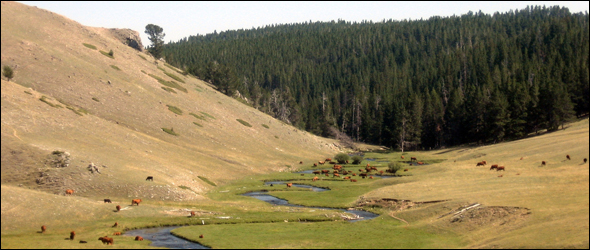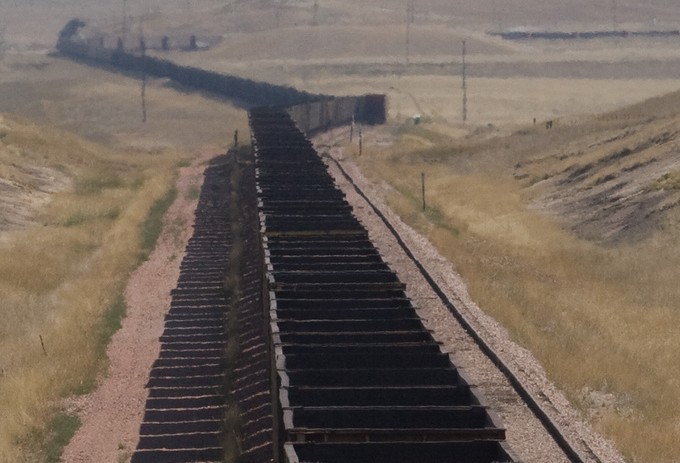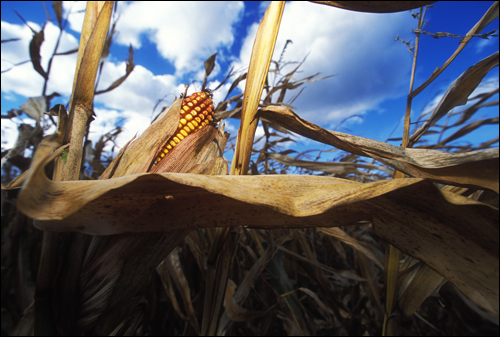Supreme Court Ruling Tests Boundaries of Water Supply and Energy Production Along Montana-Wyoming Border
Montana and Wyoming have taken their transboundary water dispute to the Supreme Court. Wyoming won the first round. But others await in a case that will help decide how much water is really available to generate energy and to produce food in one of the nation’s driest regions, as well as who has access to that water.
By Adam Moser
Circle of Blue

On April 1, the Obama administration leased 3,000 hectares (7,400 acres) of federal mineral rights in the Powder River Basin, an expanse of dryland and prairie that spans northern Wyoming and southern Montana that also produces more than 40 percent of the nation’s coal each year and 10 percent of its natural gas. The Powder, the Little Powder, and the Tongue rivers all flow north from Wyoming to Montana, watering a landscape where farmers and ranchers compete for resources with the largest energy companies in the nation.
The U.S. Department of Interior — which owns the mineral rights beneath 1.7 million of the 2.6 million hectares (4.3 million of the 6.5 million acres) in the energy-rich and water-scarce basin — has plans for 12 more, similarly big mineral lease sales over the next three years.
One month later, on May 2, the U.S. Supreme Court issued the first in a series of potentially momentous decisions on the Powder River Basin’s diminishing water supply that could reshape the limits of energy production and agriculture in the arid West. In what was likely just the first round of Montana v. Wyoming, the Supreme Court, in a seven-to-one majority decision, ruled in favor of upstream water users. In effect, although upstream water users reduce downstream water levels, this does not obligate them to use less water or to supply downstream water users with more water.
The granting of new leases to mine coal in the Powder River Basin and the expectation of more decisions to come from Montana v. Wyoming illustrates a surprising weakness in the federal government’s strategy for managing water resources in the dry American West. By issuing federal mineral leases before the Supreme Court has completed all of the rulings in the complex four-year-old case, the Interior Department is aggravating an already tense situation by creating new demands on the region’s stressed water supplies.
The government’s new leases and the Court’s decision complicate questions about how much water is really available to generate energy and to produce food in one of the nation’s driest regions, as well as who has access to that water.
Lawsuit Basics: Montana Worried About Wyoming’s Upstream Water Use
The Supreme Court ruling stems from a lawsuit, filed in 2007 by Montana, which contended that Wyoming was violating terms of the Yellowstone River Compact. The lawsuit alleges that Wyoming was taking more than its share of water from two tributaries, the Tongue and Powder rivers, which have their source in the Bighorn Mountains of Wyoming and flow into the Yellowstone River in Montana — but not before running through the heart of coal and gas country; two industries that use large volumes of water.
The Yellowstone River Compact was negotiated among Montana, Wyoming and North Dakota in 1950 and later ratified by Congress in 1951. Its basic objective was to manage the Yellowstone Basin’s water resources, preserve existing water rights, and to define the division of unallocated water.
The compact specified a three-tier system:
- First Tier: Irrigators, on both sides of the border, with water rights dating before 1950. They have first call on water from the two tributaries.
- Second Tier: Includes post-1950 water rights granted to first-tier users.
- Third Tier: New users, who supposedly get their water after first- and second-tier demands have been met.
In dry years, however, not enough water crosses the state line from Wyoming to meet the obligations of first-tier users in Montana, the state claims. Montana alleges that, while its first-tier users go without, Wyoming has allowed its users in the second and third tiers to receive water.
Montana charges in its complaint, according to an analysis by the Billings Gazette, that Wyoming has built new storage reservoirs which impermissibly hold water that should drain into the rivers; that new acreage has been put into production in Wyoming since 1950; that groundwater pumping for irrigation and coalbed methane production have reduced flows in the rivers; and that new, more efficient irrigation methods have reduced the amount of water that flows back into the rivers.
Wyoming disputes the claims, arguing that Montana has never quantified water rights on the Tongue and Powder rivers. Additionally, Wyoming asserts that the compact does not cover groundwater and tributaries of the two rivers. The groundwater issue is critical because of Wyoming’s coalbed methane industry. Wyoming also maintains that irrigators are entitled to use their entire water allotment with new, more efficient systems that don’t produce as much return water to streams as systems in use in 1950.
This whole argument gets to the point of “appropriation rights”—what are they and who has them? A fundamental tenet of Western water rights, the doctrine of appropriation holds that a first-in-time appropriator of water for beneficial use is also first in the right to enjoy that water; in other words, whoever gets to the water first owns the rights. Although the senior water rights holder generally holds rights that are superior to later appropriators, the no-injury rule places limitations on a senior appropriator’s right to change the use and amount of withdrawals if that change would injure the established rights of others. This means that the person who has had water rights for longest is allowed to increase the amount of water he or she is using, as long as it doesn’t impede on the rights of others.
The Compact states that pre-1950 appropriation rights “shall continue to be enjoyed in accordance with the laws governing the acquisition and use of water under the doctrine of appropriation.”
The first round of Montana v. Wyoming involved water use in agriculture. Montana claimed that, by switching from the flood irrigation techniques that were widely used before 1950 to a more-efficient sprinkler irrigation system, Wyoming farmers had reduced flows in the Tongue and Powder rivers by up to 25 percent and had injured Montana’s water users.
However, seven federal justices joined the majority opinion and ruled that irrigation changes which had resulted in reduced water flow to Montana did not violate Article V(A) of the Compact, so long as the water use and the area irrigated was not enlarged beyond what it was before 1950.
Water for Natural Gas Production
It is the next decision that the Supreme Court makes in the case, though, that could reshape the energy and farm sectors in the upper Great Plains region, which is experiencing hotter temperatures and more erratic precipitation in recent years due to climate change, according to government and university scientists.
The focus will be, in part, on groundwater supplies, which have become essential to natural gas production in a region that has drilled nearly 23,000 wells over the past two decades. Next to agriculture, coal mining and natural gas drilling are the largest industrial users of water, but the Yellowstone River Compact does not explicitly address groundwater.
In order to produce methane from the Powder River Basin’s coal seams, drillers typically need to pump anywhere from four to 75 cubic meters (1,000 to 20,000 gallons) of groundwater to the surface every day, depending on the age and location of the well. One recent study by the Energy Department put the average for coalbed methane wells in the Powder River Basin at 13 cubic meters (3,500 gallons) a day, after an initial period of greater water withdrawal.
In its suit, Montana asserts that Wyoming’s natural gas industry is withdrawing billions of gallons of groundwater a year to develop the Powder River Basin’s coalbed methane reserves. These water withdrawals, Montana contends, are reducing the surface flows of the Powder and Tongue rivers from Wyoming into Montana, which is a violation of the Compact.
The Court’s decision — which could come by the end of the year — is crucial to coalbed methane developers.
A Set Quantity for Montana
In his first interim report, Barton Thompson, the special master appointed by the Supreme Court to manage the Montana v. Wyoming case and to make initial rulings, ruled that the Compact limits withdrawals from groundwater that is hydrologically connected to surface flows in the region. The Supreme Court affirmed this ruling, but the exact extent to which groundwater withdrawals are responsible for reduced flow in the Tongue and Powder rivers has yet to be determined.
The question before the Court now is whether Wyoming has an obligation to deliver to Montana a set quantity of water that is sufficient under the stream conditions to satisfy Montana’s pre-1950 rights. Wyoming argues that its only duty is to do “no injury” to Montana. If Montana cannot prove specific injury — such as damage to crops or loss of livestock due to lack of water — then Wyoming has not violated its obligations under the Yellowstone River Compact.
The Court’s decision on May 2 discussed this issue and found that Article V(A) does not guarantee Montana a set quantity of water from Wyoming. However, it seems inevitable, especially during a dry period, that, eventually, a set quantity of water will be required to satisfy the rights of Montana’s water users — which is the point when coalbed methane producers would have cause to begin worrying.
If Montana is successful in arguing that Wyoming is obligated to provide a set quantity of water, and if the state can also prove that the groundwater is hydrologically connected to the Yellowstone River and its tributaries, then the water rights of Wyoming’s coalbed methane developers may be vulnerable.
According to the Court’s May opinion, Wyoming’s irrigators are permitted to deplete the flows of the Tongue and Powder Rivers beyond the levels that existed before 1950 for post-1950 users in Montana. However, the water allocated to Montana’s pre-1950 users is still protected. The consequence of the ruling is that, in dry spells, coalbed methane developers — all of which arrived after 1950 — may have to shut down their pumps in order to limit withdrawals that affect river flows to Montana. The result of that would almost certainly be much less new drilling and lower natural gas production in the Powder River Basin.
Adam Moser, a lawyer and writer, is the China Environment Fellow at Vermont Law School. Keith Schneider, senior editor for Circle of Blue, and Kevin Patrick, attorney advisor to the Water Law project, contributed to this report. Contact Keith Schneider

|
History of Discharge Regulation Lawsuits
The vast majority of legal battles involving coalbed methane production concern the regulation of water discharged from wells. A mix of state and federal agencies and laws govern surface water quality and water discharges, the interaction of which is loosely unified by the Clean Water Act. Central to this is the National Pollution Discharge Elimination System, which requires a permit for point-source discharges into U.S. surface waters. The water law also provides for citizen involvement and allows citizens to sue for violations of the law by polluters and/or the government. Until 2003, when the 9th Circuit Court of Appeals decided that the Clean Water Act mandated permits for coalbed water discharges in Northern Plains Resource Council v. Fidelity Explorations, the Montana Department of Environmental Quality (MDEQ) did not require discharge permits for coalbed wells. The MDEQ claimed coalbed well discharges were in the form of unaltered groundwater. The plaintiffs argued that, unaltered or not, coalbed discharges contained pollutants that were regulated under the federal clean water law, and the 9th Circuit agreed. After the U.S. EPA approved Montana’s more stringent water quality standards for the Tongue and Powder rivers in 2006, Wyoming’s coalbed well developers brought suit in Pennaco Energy v. U.S. EPA. The well owners sued — arguing that Montana’s new standards and the EPA’s approval of them were not scientifically — because water flowing from Wyoming would now have to meet Montana’s standards at the border, and this could potentially require coalbed wells in Wyoming to treat water before discharge. The Wyoming federal district court hearing the case ruled in favor of the well owners. In 2010, the EPA voluntarily dropped its appeal in the case. Conversely, that same year, the Montana Supreme Court ruled that, under the Clean Water Act and Montana law, all coalbed wells must treat water before discharging into surface waters, which was a de facto approval of the same standards that had been of issue in Pennaco Energy v. U.S. EPA. To solve this banter back and forth between the states, the EPA could set a national standard for coalbed water discharge — of which, there currently is none. The EPA already uses national standards for many oil- and gas-extraction processes. Even if this were not done at the national level, EPA Region 8 — the office in charge of the Powder River Basin — could issue its own regional standards, requiring coalbed wells on both sides of the Montana-Wyoming border to treat or eliminate pollutants. The EPA is investigating the applicability of setting a national standard for coalbed extraction, though there is no timeline for when, or if, it will be introduced. |
Montana Perspective: What These Rivers Mean
Roger Muggli is a third generation farmer and animal-feed producer who relies on water from the Tongue River for irrigation. He also manages the Tongue and Yellowstone River Irrigation District (T&Y Irrigation District), just as his father and grandfather did before him. Muggli is emphatic that maintaining the minimum amount of water for irrigation purposes is not enough — irrigation is only part of it. “People need to understand the whole scope of what these rivers mean to us, culturally and recreationally,” Muggli told Circle of Blue. As a young boy, Muggli rode with his grandfather and father to check on the irrigation canals, and he learned the importance of water — not only to irrigation and the family’s business, but also to the river ecosystem. He is eager to recount that, as a young boy, he enjoyed swimming and playing in the rivers. His biggest influences, though, were the fish. As water drained from the irrigation canals into the fields, he would follow behind the water and pick up stranded fish, put them into his bucket, and run them back to the river. Few people are more familiar with how water is measured and apportioned in an irrigation system, or how salty water can affect the soil and crop yields. But for Muggli, these issues can only be addressed adequately when the rivers’ flows are healthy. In 1925, Roger’s grandfather, Joseph Muggli, settled on a farm not far from Miles City, Montana. In 1950, Joseph helped author the Yellowstone River Compact, and, in 1957, Roger’s father, Don Muggli, was elected as the T&Y Irrigation District manager. Don worked in the position until Roger was elected in 1987. Remembering the fish-rescue missions of his childhood, Muggli set out to construct a fish passage around the T&Y diversion dam. For the first time since 1886, fish from the Yellowstone River would be able to swim into the Tongue River to spawn and to thrive. It took 20 years of building consensus, followed by Muggli personally moving earth and boulders during construction, but in 2007, the Muggli fish passage project was completed. |
Circle of Blue provides relevant, reliable, and actionable on-the-ground information about the world’s resource crises.







Leave a Reply
Want to join the discussion?Feel free to contribute!